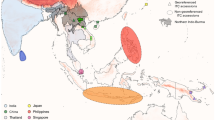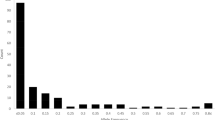Abstract
Molecular analysis of genetic diversity amongand within phenotypically similar wild Capsicum annuum var. glabriusculum(chile) populations revealed geneticdifferences among accessions spread over abroad geographic range. These chiles areregionally known as chiltepíns and are a 50metric ton per year wild harvest for the spiceindustry, as well as a genetic resource forcrop improvement. Understanding geneticvariability in this species providesinformation related to conservation efforts. The objective of this research was to surveygenetic diversity among and within an insitu population and ex situ accessionsof chiltepíns. Random AmplifiedPolymorphic DNA (RAPD) molecular markers wereused to study the genetic structure of an in situ population found at the nothernmostrange of this species and ex situaccessions collected from Mexico and Guatemala. Novel genetic variation was found in both thein situ northern disjunct population, aswell as some ex situ accessions, thussupporting conservation of this species viaboth in situ and ex situ strategies The evidence presented here supports effortsto conserve outlier populations via insitu management practices.
Similar content being viewed by others
References
Anonymous (1972) Genetic Vulnerability of Major Crops. Natl. Acad. Sci., Washington, DC.
Betancourt JL, Schuster WS, Mitton JB, Anderson RS (1991) Fossil and genetic history of a pinyon pine (Pinus Edulis) isolate. Ecology, 72, 1685–1697.
Dudley JW (1994) Comparison of genetic distance estimators using molecular marker data. In: Analysis of Molecular Marker Data: Joint Plant Breeding Symposia Series, pp. 3–7. Amer. Soc. Hort. Sci. and Crop Sci. Soc. Amer.
Gallego FJ, Martinez I (1997) Method to improve reliability of random amplified polymorphic DNA markers. Biotechniques, 23, 663–664.
Gonzalez M, Bosland PW (1991) Strategies for stemming genetic erosion of Capsicum germplasm in the Americas. Diversity, 7, 52–53.
Hayward MD, Sackvile Hamilton NR (1997) Genetic diversity population structure and conservation. In: Biotechnology and Plant Genetic Resources (eds. Callow JA, Ford-Lloyd BV, Newbury HJ), pp. 49–76. CAB Intl, Wallingford, UK.
Holsinger KD, Gottlieb LD (1991) Genetics and Conservation of Rare Plants (eds. Falk DA, Holsinger KE), pp. 195–208. Oxford University Press, New York, Oxford.
Kimura M, Weiss GH (1964) The stepping stone model of population structure and the decrease of genetic correlation with distance. Genetics, 49, 561–576.
Ledig FT, Conkle MT, Bermejo-Velazquez B, Eguiluz-Piedra T, Hodgskiss PD, Johnson DR, Dvorak WS (1999) Evidence for an extreme bottleneck in a rare Mexican Pinyon: Genetic diversity, disequilibrium, and the mating system in Pinus Maximartinezii. Evolution, 53, 91–99.
Lesica P, Allendrof FW (1995) When are peripheral population valuable for conservation? Conserv. Biol., 9, 753–769.
Linhart YB, Grant MC (1996) Evolutionary significance of local genetic differentiation in plants. Annu. Rev. Ecol. Syst., 27, 237–277.
Loiza-Figueroa, Ritland FK, Laborde-Cancino JA, Tanksley SD (1989) Patterns of genetic variation of the genus Capsicum (Solanaceae) in Mexico. Plt. Syst. and Evol., 165, 159–188.
Nei M, Li WH (1979) Mathematical model for studying genetic variation in terms of restriction endonucleases. Proc. Natl. Acad. Sci., 76(10), 5269–5273.
Paran I, Aftergoot E, Shifriss C (1998) Variation in Capsicum annuum revealed by RAPD and AFLP markers. Euphytica, 99, 167–173.
Prince JP, Lackney VK, Angeles C, Bhauth JR, Kyle M (1995) A survey of DNA polymorphism within the genus Capsicum and the fingerprinting of pepper cultivars. Genome, 38, 224–231.
Richter HE, Sandal NN, Marker KA, Sengupta-Gopalan C (1991) Characterization and genomic organization of a highly expressed late nodulin gene subfamily in soyabean. Mol. Gen. Genet., 229, 445–452.
Rodriguez JM, Berke T, Engle L, Nienhuis J (1999) Variation among and within Capsicum species revealed by RAPD markers. Theoretical Appl. Genet., 99, 147–156.
Rohlf FJ (1992) NTSYS-pc Numerical Taxonomy and Multivariate Analysis System. Setauket, NY.
Tanksley SD, McCouch SR (1997) Seed banks and molecular maps: Unlocking genetic potential from the wild. Science, 277, 1063–1066.
Tewksbury JJ, Nabhan GP, Norman D, Suzan H, Tuxill J, Donovan J (1999) In situ conservation of wild chiles and their biotic associates. Conservation Biol., 13, 98–107.
Wiersema JH, Leon B (1999) World Economic Plants. CRC Press, Boca Raton.
Author information
Authors and Affiliations
Corresponding author
Rights and permissions
About this article
Cite this article
Votava, E.J., Nabhan, G.P. & Bosland, P.W. Genetic diversity and similarity revealed via molecular analysis among and within an in situ population and ex situ accessions of chiltepín (Capsicum annuum var. glabriusculum). Conservation Genetics 3, 123–129 (2002). https://doi.org/10.1023/A:1015216504565
Issue Date:
DOI: https://doi.org/10.1023/A:1015216504565




